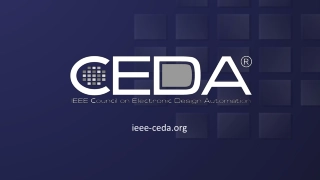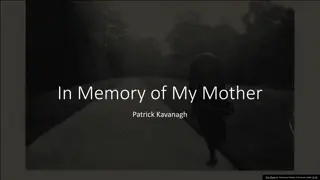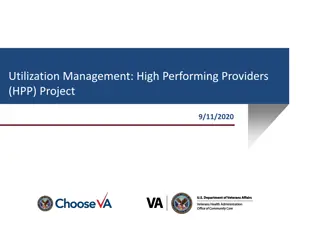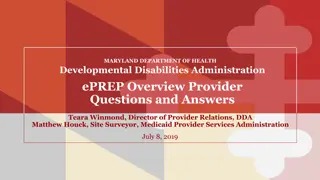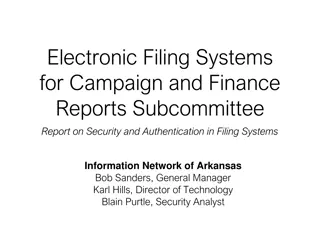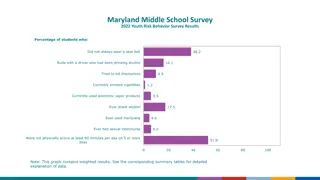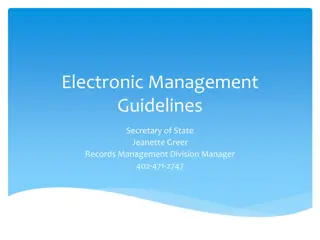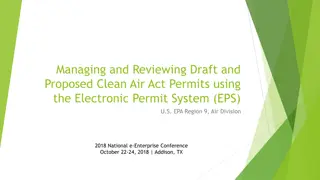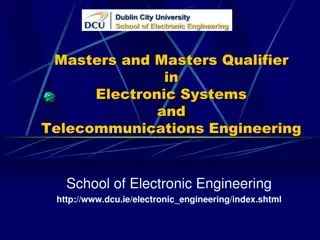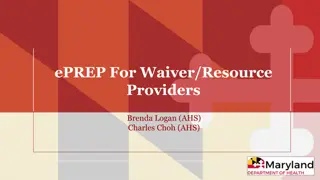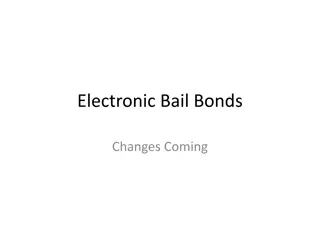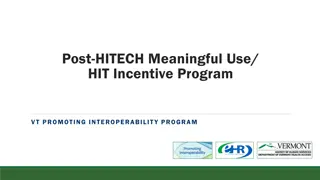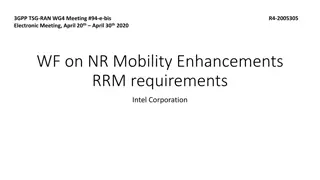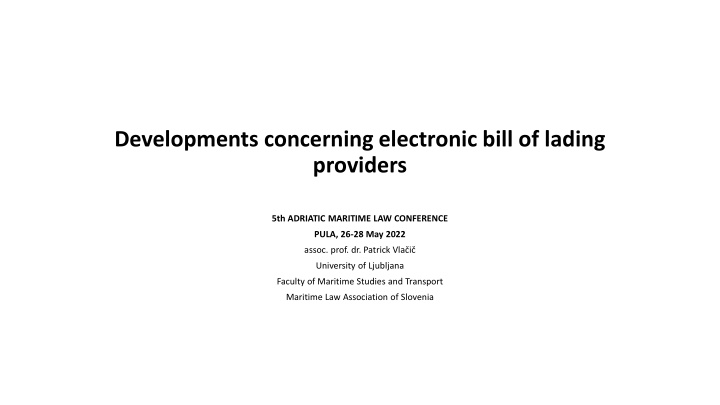
Developments in Electronic Bill of Lading and Maritime Law
Explore the latest advancements in electronic bill of lading technology and key legal frameworks such as the Hague Rules and eBill of Lading. Get insights on the impact of digitalization on maritime trade and the shift towards electronic documentation. Stay informed on initiatives like DCSA and BIMCO to streamline processes in the shipping industry.
Download Presentation

Please find below an Image/Link to download the presentation.
The content on the website is provided AS IS for your information and personal use only. It may not be sold, licensed, or shared on other websites without obtaining consent from the author. If you encounter any issues during the download, it is possible that the publisher has removed the file from their server.
You are allowed to download the files provided on this website for personal or commercial use, subject to the condition that they are used lawfully. All files are the property of their respective owners.
The content on the website is provided AS IS for your information and personal use only. It may not be sold, licensed, or shared on other websites without obtaining consent from the author.
E N D
Presentation Transcript
Developments concerning electronic bill of lading providers 5th ADRIATIC MARITIME LAW CONFERENCE PULA, 26-28 May 2022 assoc. prof. dr. Patrick Vla i University of Ljubljana Faculty of Maritime Studies and Transport Maritime Law Association of Slovenia
New developments DCSA - Digital Container Shipping Association FIATA ACI import and ACI export
Bill of Lading The document the reason for the carriers from Genova in 15thcentury for the issue of the document mistrust transport actors. At the same time, traders from the Maghreb were resolving this mistrust ad personam. Three functions of BL. The BL is considered to symbolise the goods and its transfer leads to the transfer of the rights to the cargo. Possession of the BL is equivalent to possession of the goods. The BL, evidencing the contract of carriage, enables an action in contract law.
Hague Rules 1924 Article 1 (b) "Contract of carriage" applies only to contracts of carriage covered by a bill of lading or any similar document of title, in so far as such document relates to the carriage of goods by sea, including any bill of lading or any similar document as aforesaid issued under or pursuant to a charter party from the moment at which such bill of lading or similar document of title regulates the relations between a carrier and a holder of the same.
eBill of Lading The Hamburg Rules 1978: the possibility of electronic signature of a BL. The CMI Rules for Electronic Bills of Lading 1990. UNCITRAL's Model Law on Electronic Commerce 1996 and later Model Law on Electronic Signatures Rotterdam Rules 2009 BIMCO adopted a standalone Electronic Bill of lading Clause in 2014 UNCITRAL's Model Law on Electronic Transferable Records from 2017 (some principles): A. Functional equivalence & technological neutrality B. Requirements of singularity and control C. BL has to be: original & unique D. Non-discrimination of foreign electronic transferable records
BIMCO standalone Electronic Bill of lading Clause The clause provides that at the charter s option the bills of lading, waybills, or delivery orders referred to in the charter party in electronic form shall have the same effect as their paper equivalent, that charterers shall subscribe/use an International group of P&I clubs (IG P&I) approved system and that charterers agree to hold the ship- owners harmless of additional liability for the use of an electronic system if such a liability does not arise from the shipowner s negligence.
Approval of system of electronic BL why is it essential International Group of P&I clubs Requirements for Electronic trading system providers These requirements form the generic specifications for electronic trading system providers seeking International Group of P&I Clubs Approval. If the eBL was issued by approved eBL provider then the P&I will cover the claims out of the eBL.
IG P&I requirements 1. The system must be able to accomplish a transfer of title, rights, and liabilities (endorsement as a matter of law). 2. There must be a signature provision whereby the parties agree that an electronic signature is a valid signature. 3. A mechanism is necessary whereby parties must agree not to dispute that the e-bill is a bill of lading. 4. A mechanism is necessary whereby users can sue and be sued. 5. applicable as if the e-bill were a paper bill. The system must ensure that treaties, conventions, and national laws which ordinarily apply to a paper bill of lading are
IG P&I requirements 6. The operator/system provider must accept liability in case of system failure. 7. The system must allow for clausing, accomplishment, and rejection of the e-bill. 8. There must be sufficient evidence of the terms of the contract of carriage. 9. The system must expressly exclude application of the Contracts (Rights of Third Parties) Act of 1999. 10. liabilities arising from system fault or failure of any nature. The operator or system provider must carry adequate limits of liability in their insurance to cover
Available eBL services with IG P&I approval 1. The Bolero electronic version of paper with the use of legal rulebook and technology that can replicate the functions of the traditional paper BL. 2. essDOCS (Electronic Shipping Solutions) the company offerss the BL a system called CargoDocs eB/Ls. CargoDocs is a web- based platform. The digitalization, creation and approval of electronic original documents: through DocHub and the exchange and legal transfer via DocEx. 3. e-title solution: provides contractual validity through a multilateral agreement to title transfers. Title transfers are made possible by peer-to-peer technology. 4. The edoxOnline provides the industry with a collaborative digital platform to streamline the issuance of shipping and commercial documents. 5. WAVE: distributed ledger network using blockchain technology to enable the parties in carriage and sales contract to issue, exchange, and sign different documents.They do not use a central server or registry. 6. The CargoX created the first blockchain eBL in history. The CargoX platform enables blockchain document transfer (BDT), and the company aims to build digital trust between trading companies in a mistrusting digital environment. 7. TradeLens got approved by IG P&I on 24 March 2021. TradeLens is a company jointly developed by Maersk and IBM. It uses a blockchain-based infrastructure as a platform for issuing, transferring and surrendering eBLs. The eBL is issued digitally by carriers to a shipper as a structured document. The transaction recorded on the blockchain.
Legal chalenges There are different players from different bacground that use the bill of lading and all have to agree to dematerialised BL. Question: who is entiteld to demand the original (only the beneficiary of receiving of cargo and then the issuer upon the delivery of cargo). The funcitons of BL and different players in different contracts and legal relations. 1. B2B: parties of contract of carriage (issuer to shipper, shipper to next the beneficiary or of consignee), Parties of contratct of sale (seller to bank for LC), Shipper or seller to insurance company. 2. B2A: Exporter or importer to customs office
Participants in the contract of carriage of goods (maritime) Cargo insurance Agent Liability insurance Shipper Charterer (sender) Carrier Consignee Stevedor Customs Bill of lading (BL) Customs Letter of credit (LC) Buyer S. B. Seller Bank Bank Importer Exporter
DCSA: Digital Container Shipping Association In 2019 DCSA was established for digital transformation of the container shipping industry and to prepare IT standards that would enable interoperability of technology solutions across the industry. Members: MSC, Maersk, CMA CGM, Hapag-Lloyd, ONE, Evergreen, Yang Ming, HMM and ZIM purpose is to facilitate digital interconnectivity and exchange of seamless data Standards: 2.1 of Track & Trace Interface standards, Just-in-time port call interface standards with API definitions, DCSA Interface Standard for the Bill of Lading and Bylaws on Electronic Bills of Lading.
DCSA bylaws on eBLs DCSA is promoting itself as vendor neutral and technology agnostic. DCSA B/L standards are aligned with the UN/CEFACT (United Nations Centre for Trade Facilitation and Electronic Business)
DCSA bylaws on Ebls Bylaws adopt a technology & system neutral principle so as to enable the use of various technological models, including but not limited to registry, token, distributed ledger, block chain or other technology. Bylaws apply to eBLs that are the functional equivalent of transferable documents. Bylaws do not govern any commercial transactions or other dealings between the different Users or the contents of any data, messages, communications, documents, information including any meta-data exchanged or processed. The aim of DCSA Bylaws is that latter are approved by IG P&I and that providers of eBL are aligned with these Bylaws This would allow than interoperability of different eBL providers. The DCSA Bylaws are not appoved by IG P&I, yet.
Interopoerabilty of ebl providers All seven ecosystems have different rulebook, terms and conditions or other set of rules that govern the creation, possession, transfer, surrender of eBL. They have different choice of governing law, dispute resolution. They have different business model: i.e. who is paying the expense of creation, possession, transfer, surrender The challenge is that eBL is crated in one ecosystem (eBL provider) and then transferred to another ecosystem and in some cases in more then one ecosystem. The natural position of eBL providers is to seal up the journey of eBL withing their ecosystem. When there is more than one ecosystem used, there are two types of challenge: one is legal and the other one is the question of a format of document (eBL).
Governing law DCSA BYLAWS 21. Governing Law and Jurisdiction. Notwithstanding any law and jurisdiction agreement in the Contract of Carriage, these Bylaws and the use of the Services and the Application, whether between Users and/or a User and the Service Provider, shall all be governed by and construed in accordance with English law and any dispute or matter arising out of or in connection with them shall be referred to the exclusive jurisdiction of the High Court of Justice in London. HAPPAG LLOYD S BL 25. Law and Jurisdiction Except as otherwise provided specifically herein any claim or dispute arising under this Bill of Lading shall be governed by the law of the Federal Republic of Germany and determined in the Hamburg courts to the exclusion of the jurisdiction of the courts of any other place. In case the Carrier has also the option to file a suit at the Merchant's place of business. In the event this clause is inapplicable under local law then jurisdiction and choice of law shall lie in ether port of loading or port of discharge at Carrier s option.
Interoperabilty of eBL providers The legal part of interoperability would be achieved in with the alignment of legal basis of each eBL provider with DCSA Bylaws. DCSA is closely working with IG P&I to get their approval of Bylaws. It seems that this is also in interest of IG P&I. The question of the format of transferable document is proposed to be solved by JSON (JavaScript Object Notation) format of eBL. This way there is a standardized eBL created in a shape that can be transferred from one ecosystem (eBL provider) to another. How will that be possible through API (An application programming interface) will existing providers allow that. Commercial part might be the hardest nut to crack. Different eBL providers have different business models: subscrption, every transfer is payable, only creator of eBL pays
Structured Data Format JSON is one of the structured data format: it is an open standard file format and data interchange format that uses human-readable text to store and transmit data objects consisting of attribute value pairs and arrays (or other serializable values). With structured data format different eBL service providers are able to understand each other.
Human-readable document and machine- readable document
The eBL is rendered both : oin human-readable PDF form, like a traditional BL, oand machine-readable form as structured data.
Both are stored in a file storage medium. This storage medium may be local storage, a distributed storage medium, or a hybrid of the two. The structured data is then passed into a smart contract-based token on a distributed ledger network. The eBL data includes the substantive details of the BL along with a unique identifier (a cryptographic hash) representing the content of the data.
Taken together with the address of the token, this data provides a single, unique, representation of the eBL capable of exclusive possession. the content of the eBL and the instance of the eBL are uniquely identifiable. The smart contract provides a tokenised representation of the eBL capable of being transferred between parties on the distributed ledger system. In doing so, the eBL can be shown to be exclusively possessed by the holder of the token that references the eBL data.
BL as a Hash https://xorbin.com/tools/sha256-hash-calculator Bill of lading 04113acec86004535144fd62f3e935a3978e4183955c04bbd4e6f091 50080c87 Electronic Bill of lading F6d7d9b65b933c6dcd32f0ea03f4fc9287ac83da2ca8cf4e61950ed10f e13bf7
Paper workflow replication in eBL Under the equivalency of BL and eBL is understood the complete system replication. Case of difference between possession of BL and endorsed designated beneficiary of the receipt of the cargo. Logical in hardcopy BL, not logical in eBL.
eFBL proof of concept FIATA has launched a proof of concept to test the tracking solution behind its e-FIATA Bill of Lading (eFBL). The proof of concept focuses on the development of the eFBL integrity and traceability, through its digitalization.
FIATA will make its bill of lading standard available to software providers to enable its members to issue eFBLs through their everyday tools. Each document will be stamped with a unique FIATA tracking code which will certify the validity of the document, the integrity of its content, and the identity of its issuer (as it will be linked to the digital identity profile of the FIATA member issuing the document). This stamping process will also allow FIATA, as well as all stakeholders interacting with the document, to have access to a full audit trail for each document issued. https://fiata.com/what-we-do/digitalization/projects.html
eFBL proof of concept https://youtu.be/OEBlJq3v1AM
Fiata digital identity Data is no longer shared in a bilateral way: it is now made available through ecosystems to trusted stakeholders who proactively retrieve data from its original issuer. The trust is crucial: a secured identification of the ecosystems participants is key to ensure both the data issuers and receivers can be trusted.
Fiata standard trade documents library For successful interoperability, standards are essential. eFBL interoperability is simple eFBL is the same document for all users. FIATA has a control over eFBL as it is a centralised system.
Other usage of electonic documents in maritime transport
ACI-I and ACI-E Advance Cargo Information import Advance Cargo Information export
Literature https://technation.io/wp- content/uploads/2021/06/LegalSchemaFinal.pdf

